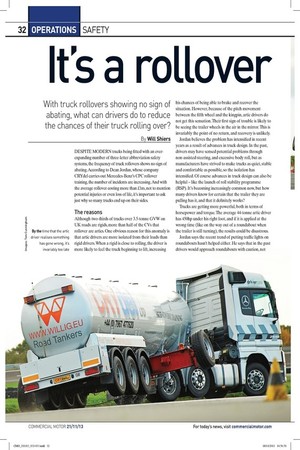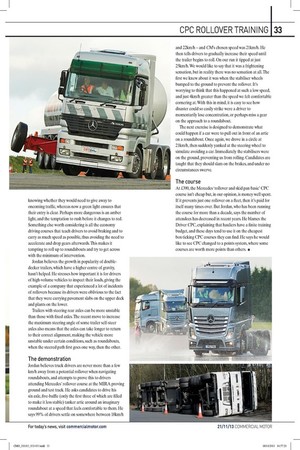It's a rollover
Page 22

Page 23

If you've noticed an error in this article please click here to report it so we can fix it.
With truck rollovers showing no sign of abating, what can drivers do to reduce the chances of their truck rolling over? By Will Shiers
DESPI IL MODERN trucks being fitted with an everexpanding number of three-letter abbreviation safety systems, the frequency of truck rollovers shows no sign of abating. According to Dean Jordan, whose company CRYdel carries out Mercedes-Benz's CPC rollover training, the number of incidents are increasing. And with the average rollover costing more than Lim, not to mention potential injuries or even loss of life, it's important to ask just why so many trucks end up on their sides. The reasons Although two-thirds of trucks over 3.5-tonne GVVV on UK roads are rigids, more than half of the CVs that rollover are artics. One obvious reason for this anomaly is that artic drivers are more isolated from their loads than rigid drivers. When a rigid is close to rolling, the driver is more likely to feel the truck beginning to lift, increasing
his chances of being able to brake and recover the situation. However, because of the pitch movement between the fifth wheel and the kingpin, artic drivers do not get this sensation. Their first sign of trouble is likely to be seeing the trailer wheels in the air in the mirror. This is invariably the point of no return, and recovery is unlikely.
Jordan believes the problem has intensified in recent years as a result of advances in truck design. In the past, drivers may have sensed potential problems through non-assisted steering, and excessive body roll, but as manufacturers have strived to make trucks as quiet, stable and comfortable as possible, so the isolation has intensified. Of course advances in truck design can also be helpful — like the launch of roll stability programme (RSP). It's becoming increasingly common now, but how many drivers know for certain that the trailer they are pulling has it, and that it definitely works?
Trucks are getting more powerful, both in terms of horsepower and torque. The average 44-tonne artic driver has 450hp under his right foot, and if it is applied at the wrong time (like on the way out of a roundabout when the trailer is still turning), the results could be disastrous. Jordan says the recent trend of putting traffic lights on roundabouts hasn't helped either. He says that in the past drivers would approach roundabouts with caution, not
knowing whether they would need to give away to oncoming traffic, whereas now a green light ensures that their entry is clear. Perhaps more dangerous is an amber light, and the temptation to rush before it changes to red. Something else worth considering is all the economy driving courses that teach drivers to avoid braking and to carry as much speed as possible, thus avoiding the need to accelerate and drop gears afterwards. This makes it tempting to roll up to roundabouts and try to get across with the minimum of intervention.
Jordan believes the growth in popularity of doubledecker trailers, which have a higher centre of gravity, hasn't helped. He stresses how important it is for drivers of high-volume vehicles to inspect their loads, giving the example of a company that experienced a lot of incidents of rollovers because its drivers were oblivious to the fact that they were carrying pavement slabs on the upper deck and plants on the lower.
Trailers with steering rear axles can be more unstable than those with fixed axles. The recent move to increase the maximum steering angle of some trailer self-steer axles also means that the axles can take longer to return to their correct alignment, making the vehicle more unstable under certain conditions, such as roundabouts, when the steered path first goes one way, then the other. The demonstration Jordan believes truck drivers are never more than a few km/h away from a potential rollover when navigating roundabouts, and attempts to prove this to drivers attending Mercedes' rollover course at the MIRA proving ground and test track. He asks candidates to drive his six-axle, five-baffle (only the first three of which are filled to make it less stable) tanker artic around an imaginary roundabout at a speed that feels comfortable to them. He says 99% of drivers settle on somewhere between 18km/h
and 22km/h — and CMs chosen speed was 21km/h. He then tells drivers to gradually increase their speed until the trailer begins to roll. On our run it tipped at just 25km/h. We would like to say that it was a frightening sensation, but in reality there was no sensation at all. The first we knew about it was when the stabiliser wheels bumped to the ground to prevent the rollover. It's worrying to think that this happened at such a low speed, and just 4km/h greater than the speed we felt comfortable cornering at. With this in mind, it is easy to see how disaster could so easily strike were a driver to momentarily lose concentration, or perhaps miss a gear on the approach to a roundabout.
The next exercise is designed to demonstrate what could happen if a car were to pull out in front of an artic on a roundabout. Once again, we drove in a circle at 21km/h, then suddenly yanked at the steering wheel to simulate avoiding a car Immediately the stabilisers were on the ground, preventing us from rolling. Candidates are taught that they should slam on the brakes, and under no circumstances swerve. The course At £390, the Mercedes 'rollover and skid pan basic' CPC course isn't cheap but, in our opinion, is money well spent. If it prevents just one rollover on a fleet, then it's paid for itself many times over. But Jordan, who has been running the course for more than a decade, says the number of attendees has decreased in recent years. He blames the Driver CPC, explaining that hauliers have a finite training budget, and these days tend to use it on the cheapest box-ticking CPC courses they can find. He says he would like to see CPC changed to a points system, where some courses are worth more points than others. •






































